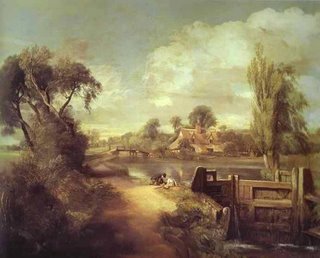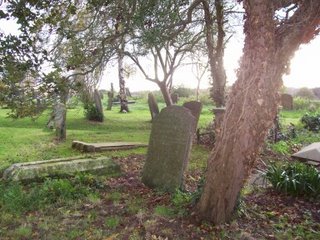 On our walk yesterday afternoon, Clara pointed out that the low November light was very much like the light in many of the paintings of John Constable (1776-1837). Did he do most of his painting in November, when the trees were yellow, green, and bare, and the low sun spread purple-gray shadows across the landscape? Here is Constable's Landscape with Boys Fishing (1813). Notice, first of all, the wooden lock, which looks exactly like the locks along the Grand Union Canal in Hatton. Then notice the November light and shadow. Compare it to the photograph below of Ashow church on a November day, at about 1:00 in the afternoon. Bluer sky (Constable was a connoisseur of clouds), but similar light, similar colors, similar shadows stretching from left to right.
On our walk yesterday afternoon, Clara pointed out that the low November light was very much like the light in many of the paintings of John Constable (1776-1837). Did he do most of his painting in November, when the trees were yellow, green, and bare, and the low sun spread purple-gray shadows across the landscape? Here is Constable's Landscape with Boys Fishing (1813). Notice, first of all, the wooden lock, which looks exactly like the locks along the Grand Union Canal in Hatton. Then notice the November light and shadow. Compare it to the photograph below of Ashow church on a November day, at about 1:00 in the afternoon. Bluer sky (Constable was a connoisseur of clouds), but similar light, similar colors, similar shadows stretching from left to right. This afternoon, I walked out into the low November sunlight, under slow-gathering rinse-water clouds that Constable could have painted on the sky. I was thinking about how I experience England both as a real and an imaginary place—a place so often transformed into paintings, poetry, and fiction. I had just read part of chapter 10 of Jane Austen's Persuasion, in which the heroine, Anne Elliot, goes on a potentially painful long walk with Captain Wentworth and the Musgrove sisters. It's November, and Anne tries to occupy her mind with poetical descriptions of autumn:
This afternoon, I walked out into the low November sunlight, under slow-gathering rinse-water clouds that Constable could have painted on the sky. I was thinking about how I experience England both as a real and an imaginary place—a place so often transformed into paintings, poetry, and fiction. I had just read part of chapter 10 of Jane Austen's Persuasion, in which the heroine, Anne Elliot, goes on a potentially painful long walk with Captain Wentworth and the Musgrove sisters. It's November, and Anne tries to occupy her mind with poetical descriptions of autumn:Her pleasure in the walk must arise from the exercise and the day, from the view of the last smiles of the year upon the tawny leaves and withered hedges, and from repeating to herself some few of the thousand poetical descriptions extant of autumn, that season of peculiar and inexhaustible influence on the mind of taste and tenderness, that season which had drawn from every poet, worthy of being read, some attempt at description, or some lines of feeling. She occupied her mind as much as possible in such like musings and quotations...
I walked as far as Old Milverton, where I wandered a while through the overgrown churchyard until I found this stone, marking the grave of a woman named Anne Elliott.




No comments:
Post a Comment